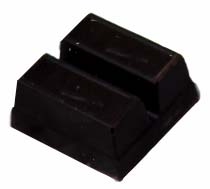

Chocolade helpt organen en systemen:
NutriŽnten in chocolade:
![]() Proanthocyanen (pure)
Proanthocyanen (pure)
![]() Koper (pure)
Koper (pure)
![]() IJzer (pure)
IJzer (pure)
Wat is de aanbevolen hoeveelheid?
Hoe wordt chocolade gemaakt?
Wat is bittere of donkere (pure) chocolade?
Waar opletten bij de keuze van donkere chocolade?
Waarom donkere chocolade?
Voedingswaarde
van 30 gram Donkere Chocolade |
|||||||
CalorieŽn |
Eiwit |
Vet |
Calcium |
Magnesium |
Fosfor |
Kalium
|
CafeÔne |
144 |
1,25 gr |
9 gr |
10 g |
35 mg |
40 mg |
109 mg |
19 mg |
Let op?
Opmerkingen
CafeÔne
Nierstenen
Migraine
Tips
Opmerkingen:
Pure chocolade bevat veel koper en dat is minder goed voor senioren.
Pure chocolade lijkt stress duidelijk te verminderen.
Vetarme chocolademelk blijkt een ideale combinatie te zijn van koolhydraten, proteÔnes, belangrijke vitamines en mineralen die belangrijk zijn voor de opbouw en het herstel van de spieren na het sporten.
Alhoewel de meeste mensen melkchocolade eten die meestal niet meer dan 20% cacao en veel suikers bevat doet pure chocolade, met minimaal 70% cacao de kans op hartfalen verlagen. Een of twee keer per week 20-30 gram van deze pure chocolade doet die kans met 32% verlagen, twee tot drie keer per maand geeft 26% minder kans op hartfalen. Iedere dag pure chocolade deed die kans echter niet veranderen.
Het af en toe eten van donkere chocola doet de kans op hartproblemen flink verminderen. Slechts een portie van gemiddeld 30 gram pure chocolade per week blijkt 50% minder kans te geven op hartproblemen, een ziekenhuisopname of het doodgaan hieraan.
Het dagelijks eten van chocola (puur met min. 70% cacao) kan de kans op een hartaanval en beroerte duidelijk verminderen.
Een onderzoek laat zien dat een combinatie tussen olijfolie en pure chocolade zorgt voor duidelijk hogere bloedwaarden goed cholesterol (HDL).
Regelmatig wat chocolade eten doet volgens studie zorgen voor een kleinere kans op diabetes en hart- en vaatziektes. Gemiddeld aten de chocolade-eters 24 gram chocolade per dag en deze hadden in vergelijking met zij die geen chocolade aten een duidelijk betere insulinetolerantie en betere leverfuncties. De positieve resultaten werden nog beter bij een hogere inname van chocolade.
De bioactieve stoffen (epi)catechinen kunnen de verwoestende gevolgen van hoge bloedsuikerwaarden duidelijk verlagen. Hierdoor kan schade aan belangrijke organen zoals hart en lever en de wanden van de slagaders worden voorkomen. Door deze schade leven diabetici wel acht jaar korter. Het regelmatig drinken van groene thee en het eten van cacao of pure chocolade kan door hun hoge hoeveelheid epicatechinen de levensverwachting duidelijk verbeteren. Een andere studie laat zien dat de bioactieve stoffen, de catechinen, in cacao ( en pure chocolade) de bŤtacellen in de alvleesklier beschermen en beter laten functioneren waardoor meer insuline aangemaakt kan worden. Hierdoor wordt beter op hoge bloedsuikerwaarden gereageerd waardoor bloedsuikerwaarden meer stabiel lager zijn.
Bij diarree wordt door de darmen veel vocht uitgescheiden. Dit wordt door een enzym (CFTR) in de darmen geregeld. Uit wetenschappelijk onderzoek nu blijkt dat de flavonoÔden in zwarte chocola (en cacao) dit enzym kunnen binden en afremmen waardoor de vochtafscheiding duidelijk afneemt.
Regelmatig chocolade eten doet volgens onderzoek NIET zorgen voor extra lichaamsvet.
Het regelmatig eten van pure chocolade gaat volgens onderzoek aderverkalking tegen.
Uit een laboratoriumstudie blijkt meer over de gezonde werking van pure chocolade in het lichaam. De bioactieve stoffen in pure chocolade als catechinen en proanthocyanen zijn doorgaans grote moleculen die moeilijk opgenomen kunnen worden in het lichaam. Doch onder invloed van goede bacteriŽn als bifidobacterium en melkzuurbacteriŽn in het maagdarmstelsel worden deze bioactieve stoffen samen met de aanwezige voedingsvezels in chocolade omgezet in kleinere moleculen met veel ontstekingsremmende werking, die gemakkelijk in het lichaam opgenomen kunnen worden. Extra inname van voedingsvezels bij het eten van chocolade kunnen volgens de onderzoekers het eten van pure chocolade nog gezonder maken.
Uit een kleine studie blijkt het eten van pure chocolade bij etalagebenen verbeteringen te geven. Na het eten van 40 gram pure chocolade (min. 85% cacao) konden de deelnemers met etalagebenen 11% verder en 15% langer lopen. De resultaten golden niet voor melk chocolade, zodat de vele bioactieve stoffen in pure chocolade voor de goede resultaten zorgden. Na het eten van de pure chocolade hadden de deelnemers duidelijk meer stikstofoxide (NO) in hun bloed, was de toestand van de bloedvaten verbeterd en werd minder oxidatieve stress gemeten. Dagelijks goede cacao geeft volgens een studie vergelijkbare resultaten.
Uit een kleine studie onder jongvolwassenen blijkt dat het dagelijks eten van een reep pure chocolade (min. 60% cacao) zorgt voor meer energie, het maakt je meer alert en gefocust en zo overwin je een middagdipje, aldus de onderzoekers. Alleen de pure chocolade bleek te zorgen dat de juiste gebieden in de hersenen werden gestimuleerd.
Een groot Deens onderzoek laat zien dat het regelmatig eten van chocola de kans op boezemfibrilleren duidelijk lijkt te verminderen.
Een paar studies laten zien dat het eten van chocolade ook goed is voor een gezonde darmflora. De cacao in de chocolade zorgt voor meer goede bacteriŽn in de darmen, de bacteriŽn die ook ontstekingen in de darmen tegengaan en verder zorgen bioactieve stoffen in cacao voor minder slechte bacteriŽn, bacteriŽn die bijv. meer aangetroffen worden bij mensen met een ontstoken darm. De hoeveelheid bioactieve stoffen die in de studies gebruikt werden zullen alleen gehaald worden bij het nuttigen van cacao of pure chocolade met zoveel mogelijk cacao.
Een kleine studie laten zien dat het eten van pure chocolade voor zowel de hersenen als het immuunsysteem goed lijkt en hoe meer cacao in de chocolade hoe beter de resultaten. Het eten van 48 gram pure (70% cacao) chocolade gaf op een EEG duidelijk meer activiteiten in de hersenen te zien op het gebied van geheugen en gegevensverwerking.
Elke dag 48 gram pure chocolade zorgt ook voor een duidelijk beter immuunsysteem zo blijkt uit een studie.
Uit een kleine studie onder 40 patiŽnten met de ziekte Multiple sclerose blijkt dat het dagelijks nuttigen van pure chocolade kan zorgen voor minder vermoeidheid. Pure chocolade met minstens 70 tot 80% cacao blijkt nodig te zijn. In de studie kregen de deelnemers dagelijkse of een drankje met vergelijkbare hoge dosering cacao of een drankje met een lage dosering. Na zes weken bleken zij met de hoge dosering 45% minder moeheid te voelen en verbeterde bij hen een loopproef met wel 80%.
Uit een Brits onderzoek onder ruim 13.000 mensen lijkt het dat het eten van donkere of pure chocola de kans op een depressie doet verlagen. Zij die dagelijks meer dan 100 gram donkere chocola aten bleken tot wel bijna 60% minder kans te hebben op een depressie. Alleen het eten van pure of donkere chocola gaf dit voordeel, het eten van melkchocolade bleek geen voordelen te geven.
Hieronder
een analyse van verschillende studies: Cocoa Flavanols: Nutraceuticals with Promising Pharmacological Properties Algemene
opmerking: Het moge duidelijk zijn dat bovenstaande gegevens indicatief zijn
en kunnen verschillen per soort en kweekmethode en -plaats. URL van deze pagina:
(18-05-2020)
Introduction
Flavonoids belong to a group of natural substances with phenolic structures built around a core flavone structure and are found in plants and food products such as
wine.[1] (Figure 1) These natural products were known for their beneficial effects for many years before flavonoids were identified. Research in flavonoids received an added impulse upon discovery of the "French paradox" observed in Mediterranean populations where a low cardiovascular mortality occurs in association with the consumption of red wine and high saturated fats. The flavonoids in red wine are suspected to be at least partly responsible for this effect.[2,3] Indeed, epidemiologic studies suggest a protective role of flavonoids against coronary heart disease.[4,5] Flavonoids can be divided on the basis of their structure into flavones, flavanols, flavonols and anthocyanins.[6] The mechanisms by which flavonoids are suspected to yield their healthy effects include, anti-oxidant, anti-inflammatory, anti-adhesive, anti-thrombotic, vasodilatory and anti-tumor effects.[7]
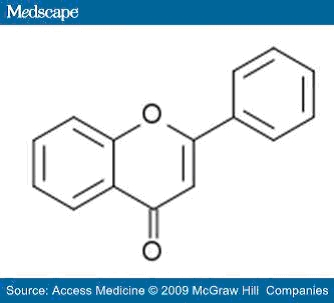
Figure 1. Polyphenolic (flavone) structure from which flavonoids are derived.
Cardiovascular Protection by Flavonoids
Flavonoids protect tissues from the adverse effects of reactive oxygen species (ROS).[7] For example, oxidized lipids damage cell membranes and induce cell death.[7] Flavonoids may act in concert with endogenous antioxidant mechanisms as an additive scavenging system. Flavonoids suppress the inducible form of NO synthase (iNOS) which yields damaging amounts of NO.[8] Flavonoids scavenge ROS via their oxidation. The flavanol epicatechin has been reported to be an ROS scavenger.[9] Since ROS can induce inflammatory mediators, their anti-oxidant properties act to suppress this response. As detailed below, flavonoids can also act as anti-inflammatory agents due to their capacity to reduce leucocyte adhesion and activation.[10,11] Anti-adhesion effects of flavonoids can also result from the inhibition of cyclooxygenase and lipoxygenase pathways[12] and synthesis of eicosanoids.[2] Flavonoids exert anti-clotting effects due to their capacity to inhibit platelet aggregation[13] and the procoagulant effects of ROS. Flavonoids are potent stimulators of endothelial NOS; the resultant production of NO produces vasodilation, anti-coagulant, and anti-adhesion effects.[7] In the context of cardiovascular pathology, the sum of all flavonoid actions can be seen as generally reducing the chances of either developing disease or mitigating ongoing pathological processes.
Cacao Beans are a Source of Flavonoids and Numerous Other Compounds
The main type of flavonoids present in cacao beans are flavanols. Cacao beans, from which chocolate is made, come from the fruit of the tree, Theobroma cacao (Figure 2), which grows mainly in subtropical regions of world. As the name theobroma ("food of the gods") suggests, the beans contain the xanthine theobromine in significant quantity, ~1.2% by weight, as well as flavonoids and nearly 400 other identified compounds. Raw cacao beans are bitter and virtually inedible (Figure 2). For the making of chocolate, cacao beans have to be fermented, roasted, ground and then separated into cocoa powder and cocoa butter.[14] Traditional processing methods that yield "modern chocolate," especially alkalinization (dutching, to mellow flavor), strips flavanols from cocoa.[14] The bitterness from cacao mostly comes from flavanols. With the emerging recognition of the beneficial effects of flavanols there has been a shift in commercial production towards chocolate forms with high flavanol content.[14] Cocoa powder can contain as little as 10% fat and has up to 6% by weight flavanols. It also has minerals (Mg, Cu, K and Ca), protein, and fiber in modest amounts. The main flavanols present in the cocoa powder are catechins and epicatechins in either monomeric or multimeric (procyanidin) forms.[15] (Figure 3) Special cocoa formulations developed by industry now contain up to 10% of cocoa flavanols.[16] Cocoa butter accounts for up to 57% of the dry weight of a bean. The predominant fatty acids are stearic, palmitic, oleic and linoleic. The ingestion of cocoa butter appears to have neutral effects on the blood lipid profile of humans and on platelet aggregation.[15] Plant sterols including sitosterol and stigmasterol are present in cocoa butter in very small amounts, and appear to have little or no impact on cholesterol absorption.[15] Thus, in spite of having saturated fat present as a constituent, cocoa butter has little or no impact on blood lipid profiles in humans.
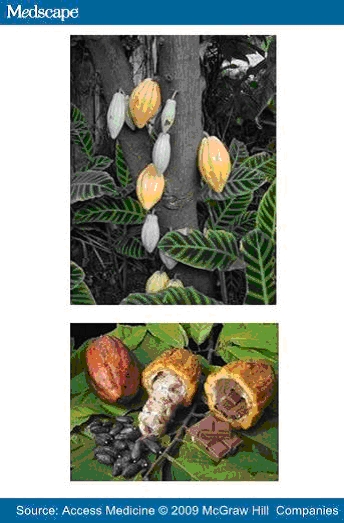
Figure 2. Theobroma cacao tree bearing its fruit (top). Pod, beans, and product of cacao (bottom).
http://www.litemexicanfood.com/history.php
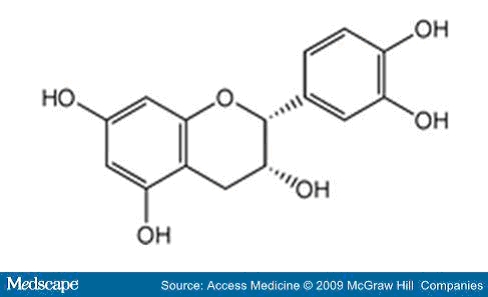
Figure 3. Chemical structure of epicatechin and its stereoisomer catechin.
Cultural History of Chocolate
The medicinal use of cacao originated in the New World hundreds of years ago among the Olmec, Maya and Mexica (Aztec) tribes. Dillinger et al. have written an excellent review on this topic from which excerpts appear below.[17]
Cacao beans held great prominence in the daily lives of Mesoamerican Indians. According to the Mayan and Mexica religions, cacao had divine origins as the god Quetzalcoatl discovered cacao. Cacao was prepared only as a beverage and was a food reserved for adult males with prominent roles in society. Columbus' crew captured a canoe that contained mysterious-looking "almonds," later identified as currency in Mesoamerica. Diaz del Castillo, an officer with Hernan Cortez wrote: "From time to time the men of Montezuma's guard brought him, in cups of pure gold, a drink made from the cocoa-plant, which they said he took before visiting his wives." The Spaniards noted that the Aztecs could walk long distances without incurring fatigue and suspected a role for the cacao beverage. Historical Mesoamerican documents include instructions for the medicinal use of cacao.[17] Ceramic pieces obtained from the Maya note a warrior in cacao armor as the Mayan's would believe that cacao would make you stronger and invincible. Modern claims for the efficacy of cocoa, based on current biomedical research, are a bit more modest but still quite impressive, as described below.
Cocoa and Cardiovascular Protection
Interest in the cardiovascular effects of cocoa flavanols reemerged recently by the observation that Kuna Indians living off the coast of Panama have a very low incidence of hypertension and no increase in blood pressure as they age. The factors involved are clearly environmental since protection is lost upon migration into the mainland.[18] The island Kuna drink large amounts of home-prepared cocoa, rich in flavanols, whereas Kuna on the mainland consume commercial cocoa that is mostly devoid of flavonoids.[16] Having discounted body weight, exercise, alcohol intake and other relevant factors as mediators of cardiovascular protection, researchers noted that the Kuna had a renal hemodynamic status suggestive of high NO levels.[16] Hollenberg et al., developed the hypothesis that the consumption of flavonoid-rich cocoa would promote vasodilation secondary to increased NO synthesis.[16] These data were confirmed in individuals consuming flavonoid-rich cocoa and the effect was reversed by the NO synthesis inhibitor L-NAME.[19,20]
Cocoa Flavanols and Cardiovascular Effects
(-)-Epicatechin and (+)-catechin have a distinctive tendency to occur in nature as subunits of larger flavanol oligomers (procyanidins) of various size.[21] Data suggest that flavanol oligomers in cocoa are degraded in the GI tract into monomers that are then absorbed either pure or in a metabolized form. The oligomers may be degraded in the acidic gastric environment or, if they reach the small intestine intact, may be decomposed to monomers. Once in the small intestine, catechin and epicatechin are substantially metabolized; the resulting flavanols are glucuronidated or methylated.[16] Some monomeric epicatechin survives and enters the body, where it causes pharmacological effects.
Cocoa powder and cocoa extracts have been shown to exhibit greater antioxidant capacity than many other flavanol-rich foods and food extracts, such as green tea and blueberries.[14] Antioxidant effects are evident immediately when compounds are used in vitro or in vivo at concentrations >0.02 mM. Among healthy humans, inhibition of LDL oxidation was reported within 2 h after the consumption of a flavanol-rich cocoa.[22] In rodents provided with cocoa orally, the rate of copper-induced LDL oxidation was significantly reduced.[23] Chronic consumption of diets with 2% cocoa powder, providing 1.57 mg/g diet of flavanols and procyanidins, was associated with reduced DNA oxidation.[24] Diabetes-induced cataracts and ex vivo lipid peroxide formation were decreased in rats given cocoa liquor.[25] In humans, the consumption of a flavonoid-rich chocolate demonstrated increased plasma antioxidant capacity that peaked 2 h after consumption and returned to baseline by 6 h.[26,27] Cocoa flavanols also possess other beneficial effects that are apparent at relatively low doses.[14] Grassi et al. demonstrated[28] that the ingestion of dark chocolate for 15 days (100 g/day containing 88 mg of flavanols or ~1.2 mg/kg/day) decreased blood pressure and serum LDL cholesterol, improved flow-mediated dilation, and improved insulin sensitivity in hypertensive patients. These effects were absent in patients taking isocaloric amounts of white chocolate. These results are quite striking given that the beneficial effects were noted not only on blood pressure but also on other cardiovascular risk factors such as LDL levels and insulin sensitivity.
Schroeter et al.[29] demonstrated that in healthy humans the ingestion of flavanol-rich cocoa was associated with acute blood elevations in NO, an enhanced flow mediated vasodilation, and augmented microcirculation. The presence in the blood of monomers of (-)-epicatechin and its metabolite, epicatechin-7-O-glucuronide, correlated with these vascular effects. The same researchers demonstrated that a mixture of flavanols metabolites induced the relaxation in preconstricted rabbit aortic rings.[29] Based on these results, one can argue that these two cacao flavanol derivatives represent the main bioactive circulating flavanol pool, although other flavanol or procyanidin (i.e., multimeric) constituents may exert additional bioactivities.
Schroeter and colleagues[29] also demonstrated that oral epicatechin emulated the acute vascular effects of cocoa. The vascular effects were abolished by inhibition of NO synthase. Also, chronic intake of cocoa augmented plasma levels of NO and urinary excretion of NO metabolites. These results suggest that the effects of (-)-epicatechin are, at least in part, causally linked to NO production in the vasculature. The beneficial effects of cocoa have also been noted in the setting of underlying disease, such as aging-induced vascular dysfunction,[30] endothelial dysfunction in smokers,[31] and in postmenopausal women.[32] Interestingly, the sustained decrease in blood pressure in hypertensive patients as seen by Grassi et al.[28] required the prolonged intake of dark chocolate. Sustained vascular effects may be secondary to either genetic or metabolic effects.[16] In vitro and in vivo data obtained from the use of red wine polyphenols indicate that they stimulate the expression of eNOS and NO release.[33,34] This response is consistent with a vasodilation that increases with time. Metabolic effects may require the accumulation of a flavanol derivative that is active over time.
Given the pleiotropic properties of cocoa flavanols, it is reasonable to propose that they could act as cardioprotectants in the setting of ischemic injury. This possibility was examined in a study published by Yamazaki et al., who explored the capacity of epicatechin to reduce short-and long-term ischemia-reperfusion myocardial injury. Epicatechin (1 mg/kg) pre-treatment was administered daily via oral gavage to rodents for 2 or 10 days. Ischemia was induced via a 45 minute coronary occlusion. Reperfusion was allowed for 48 h, 10 days, or 3 weeks while treatment continued. Measured parameters included infarct size, hemodynamics, myeloperoxidase activity (i.e., inflammation), tissue oxidative stress, and matrix metalloproteinase-9 (MMP-9) activity in 48 h groups. Cardiac morphometry was also evaluated in 3 week groups. After 2 days of treatment, no reductions in infarct size occurred. However, after 10 days of treatment, a 50% reduction in infarct size was observed (Figure 4). Epicatechin treatment yielded no changes in hemodynamics. Tissue oxidative stress and MMP-9 activity were reduced significantly with epicatechin. By 3 weeks, a 30% reduction in infarct size was observed with epicatechin, accompanied by sustained hemodynamics and preserved cardiac morphometry. These data provide evidence for epicatechin-induced cardioprotection in the setting of ischemia-reperfusion injury. The noted effects were independent of changes in hemodynamics, were sustained over time, and were accompanied by reduced levels of several indicators of tissue injury. Apparently, the regular, long-term consumption of the flavanol is required, since no protection was observed after 2 days of pre-treatment.
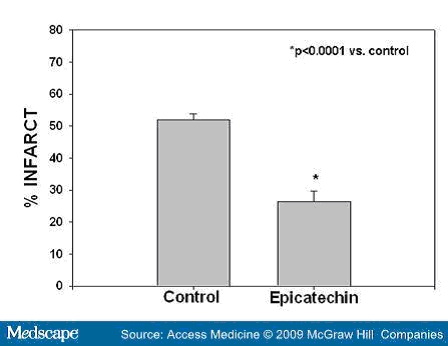
Figure 4. Decreases in infarct size in the left verticle of the heart observed in rodents pre-treated with epicatechin (author's data, from Go, K, Romero-Perez, D, Barraza, M, Cruz, M, Cortez-Gomez, B, Rivas, M, Ceballos, G, Villarreal, F: Short and long term effects of (-)-epicatechin on myocardial ischemia-reperfusion injury. Am J Physiol 295:H761-767, 2008)
On the basis of the evidence presented above, which includes epidemiological (Kuna Indians), clinical (studies in humans) and pre-clinical (using animal models), one may reasonably propose that cocoa flavanols hold promise as nutraceuticals with potent cardiovascular protective properties. Their regular consumption in forms that are low in calories should be considered, given the compelling evidence that has emerged.
References
1. Middleton, E., Jr., Effect of plant flavonoids on immune and inflammatory cell function. Adv Exp Med Biol, 1998. 439: p. 175-82.
2. Formica, J.V. and W. Regelson, Review of the biology of Quercetin and related bioflavonoids. Food Chem Toxicol, 1995. 33(12): p. 1061-80.
3. Baur, J.A., et al., Resveratrol improves health and survival of mice on a high-calorie diet. Nature, 2006.
4. Hertog, M.G., et al., Flavonoid intake and long-term risk of coronary heart disease and cancer in the seven countries study. Arch Intern Med, 1995. 155(4): p. 381-6.
5. Knekt, P., et al., Flavonoid intake and coronary mortality in Finland: a cohort study. Bmj, 1996. 312(7029): p. 478-81.
6. Rice-Evans, C.A., N.J. Miller, and G. Paganga, Structure-antioxidant activity relationships of flavonoids and phenolic acids. Free Radic Biol Med, 1996. 20(7): p. 933-56.
7. Nijveldt, R.J., et al., Flavonoids: a review of probable mechanisms of action and potential applications. Am J Clin Nutr, 2001. 74(4): p. 418-25.
8. Shoskes, D.A., Effect of bioflavonoids quercetin and curcumin on ischemic renal injury: a new class of renoprotective agents. Transplantation, 1998. 66(2): p. 147-52.
9. Hanasaki, Y., S. Ogawa, and S. Fukui, The correlation between active oxygens scavenging and antioxidative effects of flavonoids. Free Radic Biol Med, 1994. 16(6): p. 845-50.
10. Friesenecker, B., et al., Oral administration of purified micronized flavonoid fraction suppresses leukocyte adhesion in ischemia-reperfusion injury: in vivo observations in the hamster skin fold. Int J Microcirc Clin Exp, 1994. 14(1-2): p. 50-5.
11. Friesenecker, B., A.G. Tsai, and M. Intaglietta, Cellular basis of inflammation, edema and the activity of Daflon 500 mg. Int J Microcirc Clin Exp, 1995. 15 Suppl 1: p. 17-21.
12. Ferrandiz, M.L., et al., Effect of bakuchiol on leukocyte functions and some inflammatory responses in mice. J Pharm Pharmacol, 1996. 48(9): p. 975-80.
13. Osman, H.E., et al., Grape juice but not orange or grapefruit juice inhibits platelet activity in dogs and monkeys. J Nutr, 1998. 128(12): p. 2307-12.
14. Keen, C.L., et al., Cocoa antioxidants and cardiovascular health. Am J Clin Nutr, 2005. 81(1 Suppl): p. 298S-303S.
15. Steinberg, F.M., M.M. Bearden, and C.L. Keen, Cocoa and chocolate flavonoids: implications for cardiovascular health. J Am Diet Assoc, 2003. 103(2): p. 215-23.
16. Fisher, N.D. and N.K. Hollenberg, Flavanols for cardiovascular health: the science behind the sweetness. J Hypertens, 2005. 23(8): p. 1453-9.
17. Dillinger, T.L., et al., Food of the gods: cure for humanity? A cultural history of the medicinal and ritual use of chocolate. J Nutr, 2000. 130(8S Suppl): p. 2057S-72S.
18. Hollenberg, N.K., et al., Aging, acculturation, salt intake, and hypertension in the Kuna of Panama. Hypertension, 1997. 29(1 Pt 2): p. 171-6.
19. Fisher, N.D., et al., Flavanol-rich cocoa induces nitric-oxide-dependent vasodilation in healthy humans. J Hypertens, 2003. 21(12): p. 2281-6.
20. Heiss, C., et al., Vascular effects of cocoa rich in flavan-3-ols. Jama, 2003. 290(8): p. 1030-1.
21. Keen, C.L., Chocolate: food as medicine/medicine as food. J Am Coll Nutr, 2001. 20(5 Suppl): p. 436S-439S; discussion 440S-442S.
22. Kondo, K., et al., Inhibition of LDL oxidation by cocoa. Lancet, 1996. 348(9040): p. 1514.
23. Baba, S., et al., Cocoa powder enhances the level of antioxidative activity in rat plasma. Br J Nutr, 2000. 84(5): p. 673-80.
24. Orozco, T.J., J.F. Wang, and C.L. Keen, Chronic consumption of a flavanol- and procyanindin-rich diet is associated with reduced levels of 8-hydroxy-2'-deoxyguanosine in rat testes. J Nutr Biochem, 2003. 14(2): p. 104-10.
25. Osakabe, N., et al., Ingestion of proanthocyanidins derived from cacao inhibits diabetes-induced cataract formation in rats. Exp Biol Med (Maywood), 2004. 229(1): p. 33-9.
26. Lotito, S.B., et al., Influence of oligomer chain length on the antioxidant activity of procyanidins. Biochem Biophys Res Commun, 2000. 276(3): p. 945-51.
27. Rein, D., et al., Epicatechin in human plasma: in vivo determination and effect of chocolate consumption on plasma oxidation status. J Nutr, 2000. 130(8S Suppl): p. 2109S-14S.
28. Grassi, D., et al., Cocoa reduces blood pressure and insulin resistance and improves endothelium-dependent vasodilation in hypertensives. Hypertension, 2005. 46(2): p. 398-405.
29. Schroeter, H., et al., (-)-Epicatechin mediates beneficial effects of flavanol-rich cocoa on vascular function in humans. Proc Natl Acad Sci U S A, 2006. 103(4): p. 1024-9.
30. Fisher, N.D. and N.K. Hollenberg, Aging and vascular responses to flavanol-rich cocoa. J Hypertens, 2006. 24(8): p. 1575-80.
31. Heiss, C., et al., Acute consumption of flavanol-rich cocoa and the reversal of endothelial dysfunction in smokers. J Am Coll Cardiol, 2005. 46(7): p. 1276-83.
32. Wang-Polagruto, J.F., et al., Chronic consumption of flavanol-rich cocoa improves endothelial function and decreases vascular cell adhesion molecule in hypercholesterolemic postmenopausal women. J Cardiovasc Pharmacol, 2006. 47 Suppl 2: p. S177-86; discussion S206-9.
33. Diebolt, M., B. Bucher, and R. Andriantsitohaina, Wine polyphenols decrease blood pressure, improve NO vasodilatation, and induce gene expression. Hypertension, 2001. 38(2): p. 159-65.
34. Leikert, J.F., et al., Red wine polyphenols enhance endothelial nitric oxide synthase expression and subsequent nitric oxide release from endothelial cells. Circulation, 2002. 106(13): p. 1614-7.
Authors and Disclosures
Francisco Villarreal, Professor of Medicine, UCSD School of Medicine, San Diego